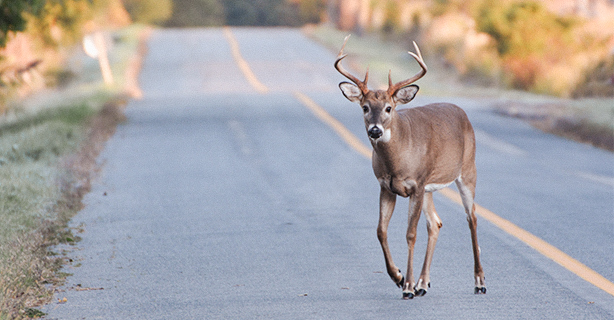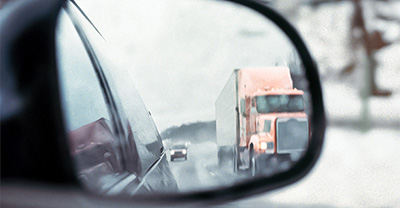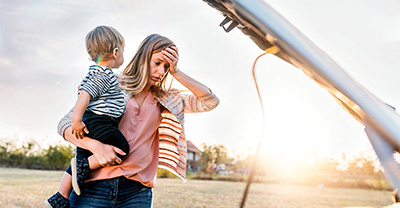What to do after hitting a deer while driving


0 min. read
You're driving down a quiet road at dusk when—bam!—a deer leaps into your path. In that split second, you don't just hear the impact—you feel it. Now what?
Every year, roughly 1.5 million deer-vehicle collisions occur in the U.S., causing around 150 deaths and over $1 billion in damage. The average insurance claim? $3,995.* While we hope you never experience this, knowing what to do after hitting a deer can be invaluable.

Stay calm after a deer–vehicle accident
Colliding with a deer can be a startling experience, but you’re not alone. These accidents can happen in an instant, and while they may lead to vehicle damage or injuries, knowing what to do next can help you stay in control.
Take a deep breath, check for injuries, and assess the situation. Your safety comes first, and we’re here to help with what to do next.
Safely pull over after hitting a deer
If possible, move your car to the shoulder, avoiding contact with the deer. Turn on your hazard lights to stay visible.
On a busy road, stay inside with your seatbelt on. If the deer blocks traffic or your car is undrivable, remain inside and call 911 immediately.
Call the police after a deer collision
Once you’re safely off the road, contact local authorities. Police can assess the scene, file an accident report—crucial for insurance claims—and guide you on next steps. They may also help remove the deer and recommend towing services if needed.
While hitting a deer isn’t illegal, failing to report significant damage or injuries could lead to issues. Some states have specific reporting requirements, so check local laws.
Document the scene
It might not be the first thing on your mind, but documenting the accident can make a big difference when filing an insurance claim. If it’s safe to do so, take photos and note key details like the time, date, and exact location.
Capture images of:
Your vehicle's damage—from all angles, plus close-ups
The surrounding area—roadway conditions, signage, and any relevant landmarks
The deer—if visible and safe to photograph
Any injuries—even minor ones should be documented and checked by a medical professional
Remember, shock can mask injuries, so don’t ignore getting checked out—even if you feel fine at first.
Don't approach the deer
If the deer remains nearby after the collision, don’t approach it. Injured wildlife can be unpredictable and may react aggressively. For your safety, keep your distance.
Gather witness information
If other drivers or pedestrians witnessed the accident, ask for their names, contact details, and a brief statement.
Contact your insurance provider
Once you’ve handled immediate concerns, notify your insurance company as soon as possible. The sooner you report the incident, the faster they can assist with your claim.
Dairyland offers 24/7 claim reporting—online or by calling 800-334-0090.
How to avoid hitting a deer
Deer collisions can happen in an instant, but you can take steps to help reduce the risk:
Stay alert in high-risk areas: Slow down when driving through rural or wooded areas, especially from dusk to dawn when deer are most active.
Be extra cautious in fall: Deer activity increases during mating season, hunting season, and migration—especially at night.
Watch the roadsides: Scan both shoulders of the road for movement, as deer often dart out unexpectedly.
Use high beams wisely: When driving at night, high beams can help you spot deer sooner—just be sure to dim them for oncoming traffic.
Vehicle safety and deer collisions
The type of vehicle you drive can impact how well you’re protected in a collision with a deer. Newer models often come with advanced safety features, such as:
Multiple airbags: Front, side, and curtain airbags offer added cushioning.
Advanced driver-assistance systems (ADAS): Some vehicles include automatic emergency braking with animal detection.
Stronger structural design: Reinforced frames and crumple zones help absorb impact.
Larger vehicles like SUVs and trucks may offer more protection due to their size and weight. However, no vehicle can prevent every accident—safe driving is your best defense.
Insurance coverage for deer–vehicle accidents
If you live in an area with a high deer population, consider purchasing coverage beyond liability. While required in most states, liability doesn't typically cover animal collisions. For that, you'll likely need comprehensive coverage, which can help pay for repairs if your vehicle is damaged by an event outside your control—like hitting a deer.
Hitting a deer is usually not considered an at-fault accident and can be covered under comprehensive insurance. But if you swerve to avoid a deer and hit another object, your claim may be classified as a collision rather than comprehensive—meaning it could be considered an at-fault accident under your policy.
If you're injured in the accident, medical payments or personal injury protection (PIP) coverages—if included in your policy—may help with medical expenses, depending on your state.

Frequently asked questions
Do I need to report a deer collision to the police?
Laws vary by state, but it’s always a good idea to contact the police—even if the deer runs away. A police report can be crucial for most insurance claims and provides an official record of the accident. While it’s not usually illegal to leave without reporting, filing an insurance claim may be more difficult without documentation proving the damage was caused by a deer.
Should I call roadside assistance right away?
Roadside assistance can be helpful, but it's not always the first step. Prioritize safety first, then notify the police—especially if there's significant damage or injuries. Once you assess your vehicle’s condition, you can arrange for a tow if needed after speaking with the police and your insurer.
What injuries are common in deer collisions?
Deer–vehicle accidents can cause various injuries, including whiplash, concussions, sprains, broken bones, cuts and bruises, and internal injuries. Even if you feel fine at first, it’s important to see a doctor—some injuries may not be immediately noticeable.
If I swerve to avoid a deer and hit something else, am I still covered?
Coverage depends on your policy. Collision coverage typically helps pay for damage if you hit another object, like a tree or guardrail. Comprehensive coverage usually applies only if you hit the deer itself. Since coverage details vary, check with your insurance provider for specifics.
Can I claim the deer carcass after the accident?
Don’t assume you can take the deer home. Laws differ by state, so contact local authorities to find out what’s allowed in your area. Following the proper procedures will help you avoid legal issues.
The general information in this blog is for informational or entertainment purposes only. View our blog disclaimer.
*Data accuracy is subject to this article's publication date.










